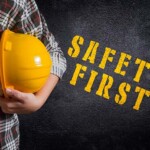What Does It Mean to Have a Safety Culture?
by Carol Keyes, CSP & Janet L. Keyes, CIH
You wouldn’t give back a just-painted car that had fish eyes to a customer. Nor would you return a vehicle that was not properly aligned. The quality of the work you do is important; it keeps customers returning and it protects you from a lawsuit if a vehicle is an accident, with claims of causation due to poor repair work. The safety of customers is important to your business.
 So is the safety of your employees. An employee who is out of work due to an injury is costly, with workers’ comp being only part of the cost. Your production capability is lower. Other employees need to make up the work, making them more prone to injury if they are working too much overtime, if they are fatigued or if they are stressed.
So is the safety of your employees. An employee who is out of work due to an injury is costly, with workers’ comp being only part of the cost. Your production capability is lower. Other employees need to make up the work, making them more prone to injury if they are working too much overtime, if they are fatigued or if they are stressed.
The employee home with an injury is losing income. They are in pain, maybe having to go to therapy several times a week. They cannot do what they used to do, which puts stress on the family.
So, how do you help prevent injuries? We may not be able to prevent all of them, but we can reduce them and control what does happen. How do you enforce quality? You let employees know that it is important to your business. You show them what you expect. You coach them. Same with safety. Call out unsafe behaviors. And call out safe actions, too, so employees know you value that.
Set the example when you walk through your shop. Wear safety glasses. If it’s loud, put on earmuffs. If something’s out of place, blocking a fire extinguisher, an electrical panel or an exit, move it. If you see an unlabeled container, label it.
Make sure employees have the personal protective equipment they need, and that it fits. You’re legally obligated to provide them with the safety glasses, hearing protection and respirators needed for the job. This is not a place to skimp – if safety glasses get scratched up, employees won’t wear them. If the only type of hearing protection you provide are earplugs that employees find uncomfortable (or that don’t fit their ear canals), they won’t wear them.
Encourage employees to let you know when they need a different tool, or a scaffold, or if a piece of equipment needs repair. And, act on that information. Responding to employee concerns and suggestions in a positive way is the best way to reinforce that their safety matters to you.
Provide safety training. Once a year for Right to Know/Hazard Communication is a great start, but add a quick safety reminder at shop meetings. Ask for feedback or concerns. Keeping safety in front of employees reinforces the importance of safety.
Work with employees to address the hazards of the job. An insurance company’s loss control rep, a safety consultant, the fire marshal, or OSHA might walk through your shop, but they’re seeing just a snapshot of what goes on. They’ll notice problems like a blocked exit, but unless the timing’s right, they won’t see the technician who starts a fire when he uses a torch because he left a rag in the way, or the detailer who sprays wheel acid without any eye or skin protection.
Have you ever heard of job hazard analyses? They’re also called job safety analyses. Fancy names for a simple process of walking through a job, step by step, to identify its hazards and come up with controls. Sort of like blueprinting a car. Ask your employees what tasks they think are the most hazardous. Then evaluate the top tasks. Work with them to list the steps – and the control measures they should be taking to prevent harm. A simple example: using a floor jack. What could go wrong with placing it? With jacking up the vehicle? With lowering it?
We’re not suggesting you do the job hazard analysis for every job. Instead, consider it as one tool to get you and your employees thinking about a safe workplace. Your employees are your best resource for identifying and controlling the hazards in the workplace. They may not know the hazards of a particular chemical, but they know what they use and how they use it.
When we talk with shop owners, we often hear them lament about the difficulty in finding skilled technicians. That makes keeping good people critical to your success. What if those good employees can’t work because they’ve been injured? If you make the investment in their safety and health now, it will pay off.
Want more? Check out the April 2024 issue of AASP-MN News!
